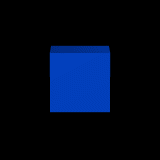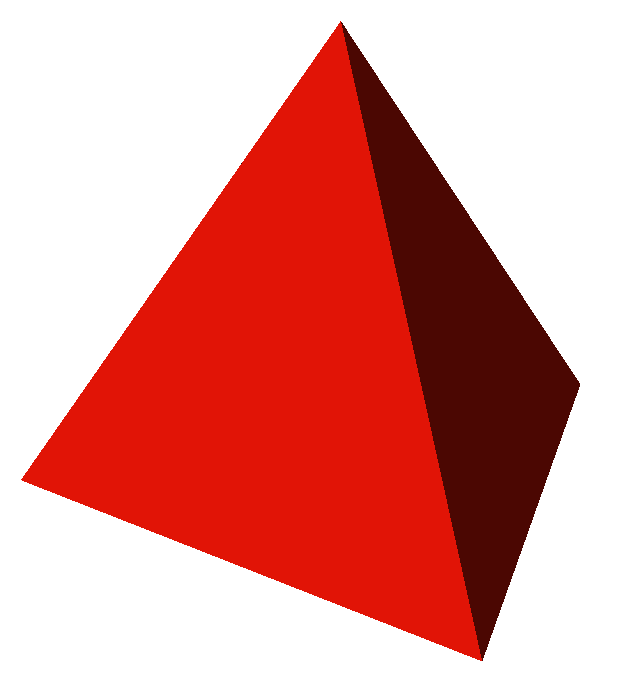|
Rhombicuboctahedron
In geometry, the rhombicuboctahedron is an Archimedean solid with 26 faces, consisting of 8 equilateral triangles and 18 squares. It was named by Johannes Kepler in his 1618 Harmonices Mundi, being short for ''truncated cuboctahedral rhombus'', with cuboctahedral rhombus being his name for a rhombic dodecahedron. The rhombicuboctahedron is an Archimedean solid, and its dual is a Catalan solid, the deltoidal icositetrahedron. The elongated square gyrobicupola is a polyhedron that is similar to a rhombicuboctahedron, but it is not an Archimedean solid because it is not vertex-transitive. The rhombicuboctahedron is found in diverse cultures in architecture, toys, the arts, and elsewhere. Construction The rhombicuboctahedron may be constructed from a cube by drawing a smaller one in the middle of each face, parallel to the cube's edges. After removing the edges of a cube, the squares may be joined by adding more squares adjacent between them, and the corners may be filled by th ... [...More Info...] [...Related Items...] OR: [Wikipedia] [Google] [Baidu] |
Elongated Square Gyrobicupola
In geometry, the elongated square gyrobicupola is a polyhedron constructed by two square cupolas attaching onto the bases of octagonal prism, with one of them rotated. It is a Midsphere#Canonical polyhedron, canonical polyhedron. It is not considered to be an Archimedean solid because it lacks a set of global symmetries that map every vertex to every other vertex, unlike the 13 Archimedean solids. However, it was once mistakenly considered a rhombicuboctahedron by many mathematicians. For this reason, it is also known as the pseudo-rhombicuboctahedron, Miller solid, or Miller–Askinuze solid. Construction The elongated square gyrobicupola can be constructed similarly to the rhombicuboctahedron, by attaching two regular square cupolas onto the bases of an octagonal prism, a process known as Elongation (geometry), elongation. The difference between these two polyhedrons is that one of the two square cupolas is twisted by 45 degrees, a process known as ''gyration'', makin ... [...More Info...] [...Related Items...] OR: [Wikipedia] [Google] [Baidu] |
Deltoidal Icositetrahedron
In geometry, the deltoidal icositetrahedron (or trapezoidal icositetrahedron, tetragonal icosikaitetrahedron, tetragonal trisoctahedron, strombic icositetrahedron) is a Catalan solid. Its 24 faces are congruent kites. The deltoidal icositetrahedron, whose dual is the (uniform) rhombicuboctahedron, is tightly related to the pseudo-deltoidal icositetrahedron, whose dual is the pseudorhombicuboctahedron; but the actual and pseudo-d.i. are not to be confused with each other. Cartesian coordinates In the image above, the long body diagonals are those between opposite red vertices and between opposite blue vertices, and the short body diagonals are those between opposite yellow vertices.Cartesian coordinates for the vertices of the deltoidal icositetrahedron centered at the origin and with long body diagonal length 2 are: *red vertices (lying in 4-fold symmetry axes): :\left( \pm 1 , 0 , 0 \right) , \left( 0 , \pm 1 , 0 \right) , \left( 0 , 0 , \pm 1 \right) ; *blue ver ... [...More Info...] [...Related Items...] OR: [Wikipedia] [Google] [Baidu] |
Uniform Polyhedron
In geometry, a uniform polyhedron has regular polygons as Face (geometry), faces and is vertex-transitive—there is an isometry mapping any vertex onto any other. It follows that all vertices are congruence (geometry), congruent. Uniform polyhedra may be Regular polyhedron, regular (if also Isohedral figure, face- and Isotoxal figure, edge-transitive), Quasiregular polyhedron, quasi-regular (if also edge-transitive but not face-transitive), or Semiregular polyhedron, semi-regular (if neither edge- nor face-transitive). The faces and vertices don't need to be Convex polyhedron, convex, so many of the uniform polyhedra are also Star polyhedron, star polyhedra. There are two infinite classes of uniform polyhedra, together with 75 other polyhedra. They are 2 infinite classes of Prism (geometry), prisms and antiprisms, the convex polyhedrons as in 5 Platonic solids and 13 Archimedean solids—2 Quasiregular polyhedron, quasiregular and 11 Semiregular polyhedron, semiregular&m ... [...More Info...] [...Related Items...] OR: [Wikipedia] [Google] [Baidu] |
Archimedean Solid
The Archimedean solids are a set of thirteen convex polyhedra whose faces are regular polygon and are vertex-transitive, although they aren't face-transitive. The solids were named after Archimedes, although he did not claim credit for them. They belong to the class of uniform polyhedra, the polyhedra with regular faces and symmetric vertices. Some Archimedean solids were portrayed in the works of artists and mathematicians during the Renaissance. The elongated square gyrobicupola or ' is an extra polyhedron with regular faces and congruent vertices, but it is not generally counted as an Archimedean solid because it is not vertex-transitive. The solids The Archimedean solids have a single vertex configuration and highly symmetric properties. A vertex configuration indicates which regular polygons meet at each vertex. For instance, the configuration 3 \cdot 5 \cdot 3 \cdot 5 indicates a polyhedron in which each vertex is met by alternating two triangles and two pentagons. Highl ... [...More Info...] [...Related Items...] OR: [Wikipedia] [Google] [Baidu] |
Square Cupola
In geometry, the square cupola (sometimes called lesser dome) is a cupola with an octagonal In geometry, an octagon () is an eight-sided polygon or 8-gon. A '' regular octagon'' has Schläfli symbol and can also be constructed as a quasiregular truncated square, t, which alternates two types of edges. A truncated octagon, t is a hex ... base. In the case of all edges being equal in length, it is a Johnson solid, a Convex set, convex polyhedron with Regular polygon, regular faces. It can be used to construct many other polyhedrons, particularly other Johnson solids. Properties The square cupola has 4 triangles, 5 squares, and 1 octagon as their faces; the octagon is the base, and one of the squares is the top. If the edges are equal in length, the triangles and octagon become Regular polygon, regular, and the edge length of the octagon is equal to the edge length of both triangles and squares. The dihedral angle between both square and triangle is approximately 144.7^\cir ... [...More Info...] [...Related Items...] OR: [Wikipedia] [Google] [Baidu] |
Vertex-transitive
In geometry, a polytope (e.g. a polygon or polyhedron) or a tiling is isogonal or vertex-transitive if all its vertices are equivalent under the symmetries of the figure. This implies that each vertex is surrounded by the same kinds of face in the same or reverse order, and with the same angles between corresponding faces. Technically, one says that for any two vertices there exists a symmetry of the polytope mapping the first isometrically onto the second. Other ways of saying this are that the group of automorphisms of the polytope '' acts transitively'' on its vertices, or that the vertices lie within a single '' symmetry orbit''. All vertices of a finite -dimensional isogonal figure exist on an -sphere. The term isogonal has long been used for polyhedra. Vertex-transitive is a synonym borrowed from modern ideas such as symmetry groups and graph theory. The pseudorhombicuboctahedronwhich is ''not'' isogonaldemonstrates that simply asserting that "all vertices look ... [...More Info...] [...Related Items...] OR: [Wikipedia] [Google] [Baidu] |
Regular Octagon
In geometry, an octagon () is an eight-sided polygon or 8-gon. A ''regular polygon, regular octagon'' has Schläfli symbol and can also be constructed as a quasiregular Truncation (geometry), truncated square, t, which alternates two types of edges. A truncated octagon, t is a hexadecagon, . A 3D analog of the octagon can be the rhombicuboctahedron with the triangular faces on it like the replaced edges, if one considers the octagon to be a truncated square. Properties The sum of all the internal angles of any octagon is 1080°. As with all polygons, the external angles total 360°. If squares are constructed all internally or all externally on the sides of an octagon, then the midpoints of the segments connecting the centers of opposite squares form a quadrilateral that is both equidiagonal quadrilateral, equidiagonal and orthodiagonal quadrilateral, orthodiagonal (that is, whose diagonals are equal in length and at right angles to each other).Dao Thanh Oai (2015), "Equila ... [...More Info...] [...Related Items...] OR: [Wikipedia] [Google] [Baidu] |
Cube (geometry)
A cube or regular hexahedron is a three-dimensional space, three-dimensional solid object in geometry, which is bounded by six congruent square (geometry), square faces, a type of polyhedron. It has twelve congruent edges and eight vertices. It is a type of parallelepiped, with pairs of parallel opposite faces, and more specifically a rhombohedron, with congruent edges, and a rectangular cuboid, with right angles between pairs of intersecting faces and pairs of intersecting edges. It is an example of many classes of polyhedra: Platonic solid, regular polyhedron, parallelohedron, zonohedron, and plesiohedron. The dual polyhedron of a cube is the regular octahedron. The cube can be represented in many ways, one of which is the graph known as the cubical graph. It can be constructed by using the Cartesian product of graphs. The cube is the three-dimensional hypercube, a family of polytopes also including the two-dimensional square and four-dimensional tesseract. A cube with 1, unit s ... [...More Info...] [...Related Items...] OR: [Wikipedia] [Google] [Baidu] |
Cantellation (geometry)
In geometry, a cantellation is a 2nd-order truncation in any dimension that bevels a regular polytope at its edges and at its vertices, creating a new facet in place of each edge and of each vertex. Cantellation also applies to regular tilings and honeycombs. Cantellating a polyhedron is also rectifying its rectification. Cantellation (for polyhedra and tilings) is also called '' expansion'' by Alicia Boole Stott: it corresponds to moving the faces of the regular form away from the center, and filling in a new face in the gap for each opened edge and for each opened vertex. Notation A cantellated polytope is represented by an extended Schläfli symbol ''t''0,2 or ''r''\beginp\\q\\...\end or ''rr''. For polyhedra, a cantellation offers a direct sequence from a regular polyhedron to its dual. Example: cantellation sequence between cube and octahedron: Example: a cuboctahedron is a cantellated tetrahedron. For higher-dimensional polytopes, a cantellation offers a direc ... [...More Info...] [...Related Items...] OR: [Wikipedia] [Google] [Baidu] |
Expansion (geometry)
In geometry, expansion is a polytope operation where Facet (mathematics), facets are separated and moved radially apart, and new facets are formed at separated elements (Vertex (geometry), vertices, Edge (geometry), edges, etc.). Equivalently this operation can be imagined by keeping facets in the same position but reducing their size. The expansion of a Regular polytope, regular convex polytope creates a uniform polytope, uniform convex polytope. For polyhedra, an expanded polyhedron has all the Face (geometry), faces of the original polyhedron, all the faces of the dual polyhedron, and new square faces in place of the original edges. Expansion of regular polytopes According to Coxeter, this multidimensional term was defined by Alicia Boole StottCoxeter, ''Regular Polytopes'' (1973), p. 123. p.210 for creating new polytopes, specifically starting from regular polytopes to construct new uniform polytopes. The ''expansion'' operation is symmetric with respect to a regular p ... [...More Info...] [...Related Items...] OR: [Wikipedia] [Google] [Baidu] |





